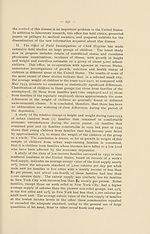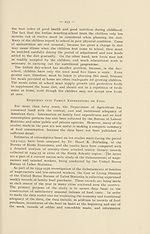Download files
Complete book:
Individual page:
Thumbnail gallery: Grid view | List view

252
A greatly diminished use of milk, vegetables and fruits was associated
with lower incomes in all the communities in the study. In the five
cities, the average supply of milk purchased by families with income
less than $2 per capita per week was one-third less than minimum
requirements, and average amounts of fresh and canned vegetables
and fruits were about equal to minimum needs. Bread and cereals
were also used in smaller amounts than is recommended for a low-cost
diet. On the other hand, amounts of meat and fish, eggs and sugary
foods purchased, though less than amounts purchased by higher-income
families, exceeded the quantities recommended for an adequate low-cost
diet. The result was a dietary low in calcium and vitamins.
In New York City, the average dietary of the lowest-income families
included adequate quantities of fresh and canned vegetables and
minimum amounts of milk. However, the period of canvass in New
York City extended later into the spring season than did that in the
five cities. In these families which had a food supply with less caloric
value than the minimum need, the use of such cheap high-caloric foods
as bread and cereals, dried legumes and potatoes was less than is
recommended for a low-cost diet.
The families in the mining towns of West Virginia and the cotton-mill
villages of South Carolina whose weekly income was less than $2 per
person purchased less than half the requirements for milk in a restricted
diet and also used too little fruit. The average amount of fresh and
canned vegetables reported by families in the mining towns was below
minimum requirements, and that for mill-village families approximately
equalled the minimum requirements.
In Birmingham, the food supply of the lowest-income families was
deficient chiefly in milk.
The United States Public Health Service furnishes medical service
for the Office of Indian Affairs of the Department of the Interior, and
this office is attempting to improve the nutrition of the American
Indian. Efforts are being made to give Indian children in boarding-
schools and in day-schools a balanced ration in conformity with
budgetary allotments. It has been observed that the Indian children
in boarding-schools gain in weight and are physically much better
after a sojourn in the school than at the time of arrival. It is believed
that the boarding-school diets are largely responsible. The same thing
is true of day-school pupils to whom hot lunches are furnished. Hot
lunches are common throughout the Indian day-schools. The field
personnel, as a part of the regular public health programme, stress
the importance of nutrition and proper diet through their health
educational work and the extension division is teaching Indian pupils
to can and preserve foods, which is regarded as an important phase
of the question and is being carried out on a large scale.
The problem of the Indian boarding-school is to provide food for
optimal nutrition at a moderate cost. Usually adequate nutrition will
be indicated by the normal growth of the children in weight and height.
A greatly diminished use of milk, vegetables and fruits was associated
with lower incomes in all the communities in the study. In the five
cities, the average supply of milk purchased by families with income
less than $2 per capita per week was one-third less than minimum
requirements, and average amounts of fresh and canned vegetables
and fruits were about equal to minimum needs. Bread and cereals
were also used in smaller amounts than is recommended for a low-cost
diet. On the other hand, amounts of meat and fish, eggs and sugary
foods purchased, though less than amounts purchased by higher-income
families, exceeded the quantities recommended for an adequate low-cost
diet. The result was a dietary low in calcium and vitamins.
In New York City, the average dietary of the lowest-income families
included adequate quantities of fresh and canned vegetables and
minimum amounts of milk. However, the period of canvass in New
York City extended later into the spring season than did that in the
five cities. In these families which had a food supply with less caloric
value than the minimum need, the use of such cheap high-caloric foods
as bread and cereals, dried legumes and potatoes was less than is
recommended for a low-cost diet.
The families in the mining towns of West Virginia and the cotton-mill
villages of South Carolina whose weekly income was less than $2 per
person purchased less than half the requirements for milk in a restricted
diet and also used too little fruit. The average amount of fresh and
canned vegetables reported by families in the mining towns was below
minimum requirements, and that for mill-village families approximately
equalled the minimum requirements.
In Birmingham, the food supply of the lowest-income families was
deficient chiefly in milk.
The United States Public Health Service furnishes medical service
for the Office of Indian Affairs of the Department of the Interior, and
this office is attempting to improve the nutrition of the American
Indian. Efforts are being made to give Indian children in boarding-
schools and in day-schools a balanced ration in conformity with
budgetary allotments. It has been observed that the Indian children
in boarding-schools gain in weight and are physically much better
after a sojourn in the school than at the time of arrival. It is believed
that the boarding-school diets are largely responsible. The same thing
is true of day-school pupils to whom hot lunches are furnished. Hot
lunches are common throughout the Indian day-schools. The field
personnel, as a part of the regular public health programme, stress
the importance of nutrition and proper diet through their health
educational work and the extension division is teaching Indian pupils
to can and preserve foods, which is regarded as an important phase
of the question and is being carried out on a large scale.
The problem of the Indian boarding-school is to provide food for
optimal nutrition at a moderate cost. Usually adequate nutrition will
be indicated by the normal growth of the children in weight and height.
Set display mode to:
![]() Universal Viewer |
Universal Viewer | ![]() Mirador |
Large image | Transcription
Mirador |
Large image | Transcription
Images and transcriptions on this page, including medium image downloads, may be used under the Creative Commons Attribution 4.0 International Licence unless otherwise stated. ![]()
| League of Nations > Economic and financial section > Problem of nutrition > (254) |
|---|
| Permanent URL | https://digital.nls.uk/190927064 |
|---|
| Shelfmark | LN.II |
|---|
| Description | Over 1,200 documents from the non-political organs of the League of Nations that dealt with health, disarmament, economic and financial matters for the duration of the League (1919-1945). Also online are statistical bulletins, essential facts, and an overview of the League by the first Secretary General, Sir Eric Drummond. These items are part of the Official Publications collection at the National Library of Scotland. |
|---|---|
| Additional NLS resources: |
|

